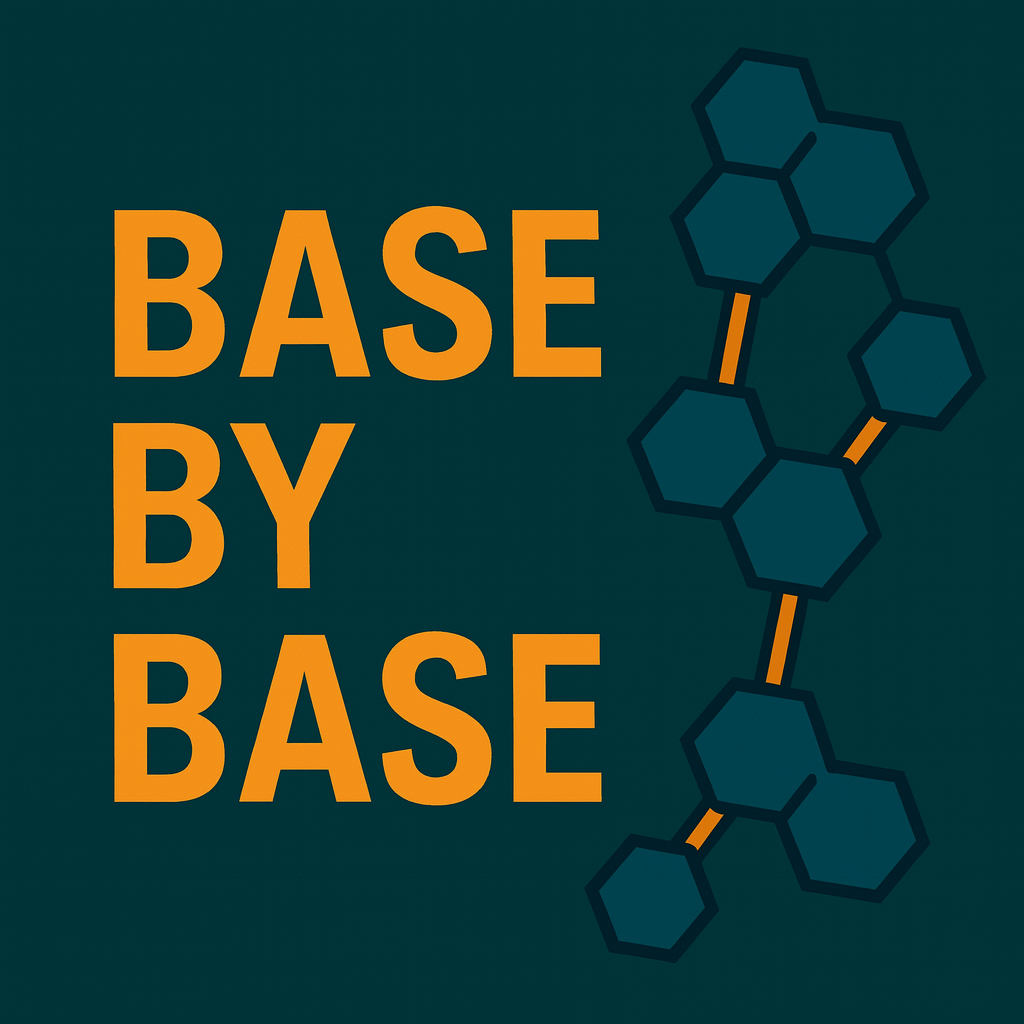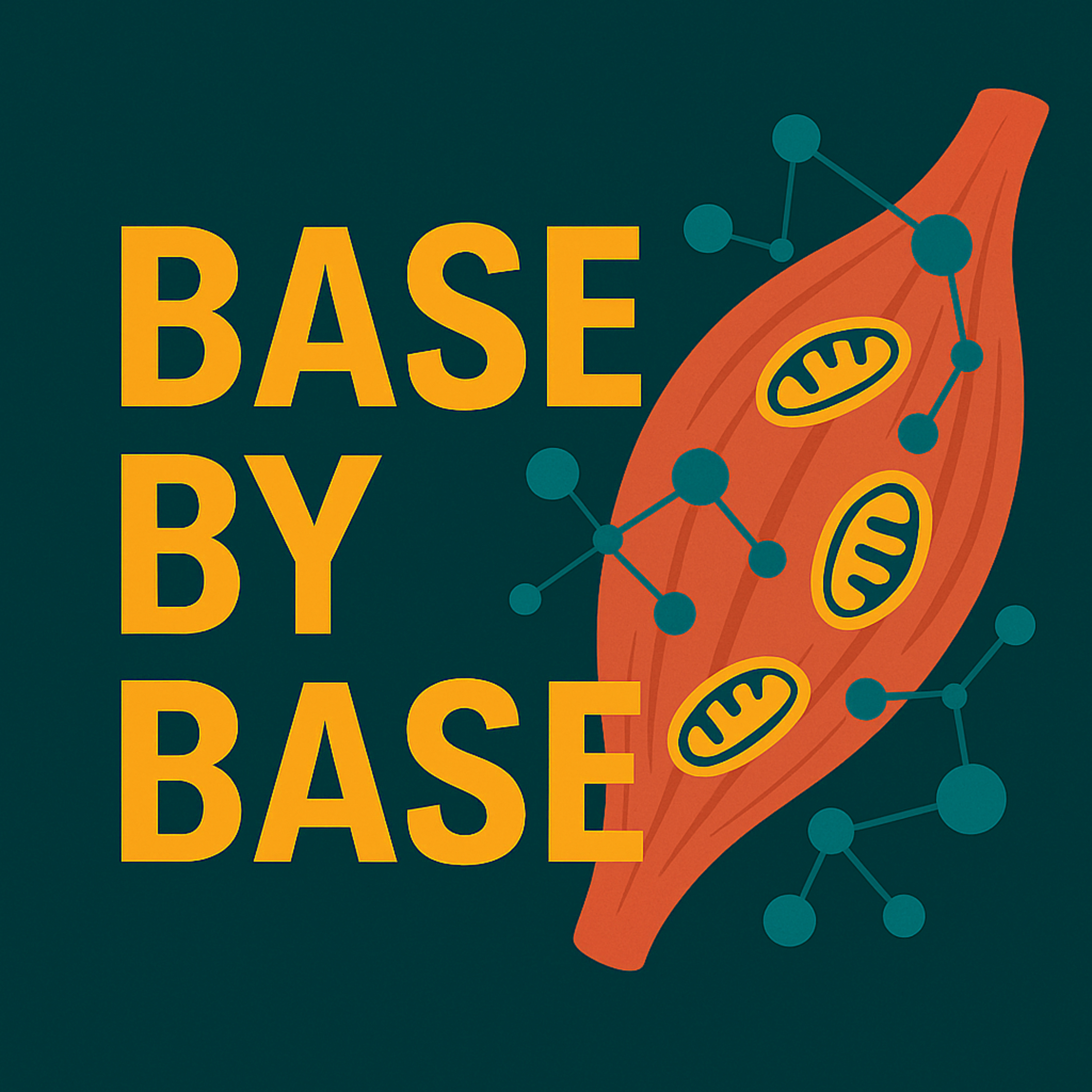Episode Transcript
[00:00:00] Speaker A: Foreign.
Welcome to Base by Bass, the papercast that brings genomics to you wherever you are. Okay. Imagine a time of incredible vulnerability right at the very beginning of life. A child's brain is developing, growing at this just astonishing rate.
[00:00:29] Speaker B: It's a critical window.
[00:00:31] Speaker A: Absolutely.
And what if during this hyperspeed development, certain structures within our DNA, you know, the actual blueprint of life, become ticking time bombs? Especially when a really crucial repair mechanism, like a cellular guardian angel isn't quite working properly.
[00:00:49] Speaker B: Okay, I see where you're going with this.
[00:00:50] Speaker A: Yeah. This isn't just hypothetical. It's a real challenge faced by specific cells in the developing brain. And it's a challenge that can tragically lead to a pretty devastating childhood cancer.
[00:01:00] Speaker B: Right.
[00:01:01] Speaker A: So today we're diving into how these unusual DNA shapes are called G quadruplexes, how they can become this profound source of vulnerability when A key gene, BRCA2, isn't working correctly.
[00:01:11] Speaker B: And BRCA2 rings a bell for many people, but probably not in this context.
[00:01:15] Speaker A: Exactly. You might be thinking BRCA2 isn't that like the breast cancer gene? And yes, it is heavily linked there. But what's truly astonishing and what this research highlights is how its vital role extends way beyond that.
It influences how our brains develop, and crucially, how certain really aggressive cancers can take hold in childhood.
[00:01:38] Speaker B: It really sounds like a perfect storm scenario. You've got the immense demands of rapid cell division.
[00:01:42] Speaker A: Right.
[00:01:43] Speaker B: The speed combined with a specific genetic vulnerability. So the faulty BRCA2 and then these unique DNA structures, the G4s, they all.
[00:01:51] Speaker A: Converge, creates the conditions for disease.
[00:01:54] Speaker B: It really does. And it forces us to ask, well, what exactly is breaking down at the molecular level when these fundamental protective systems fail, you know, what's happen inside the cell? And maybe more importantly, how can we intervene?
[00:02:05] Speaker A: Well, speaking of that, today we really want to celebrate the groundbreaking work of a dedicated team from the Rockefeller University, along with their collaborators from places like the Wellcome Sanger Institute and the nih.
Their research, which was published in pnas, it significantly advances our understanding of these specific molecular weak spots, the vulnerabilities in BRCA2 deficient cells that unfortunately lead to Medulloblastoma.
[00:02:31] Speaker B: They've really uncovered something important here. A previously, I'd say, underappreciated source of DNA replication. Stress.
[00:02:37] Speaker A: Yeah, it really changes the perspective. Okay, so let's unpack this complex picture a bit more. We're talking about medulloblastoma, right? Often called mb, and it's the most common malignant brain tumor in children, specifically this study zeros in on a subgroup known as sonic hedgehog medulloblastoma, or SHH mb.
[00:02:56] Speaker B: That's right. And for some children, unfortunately, this diagnosis comes with an inherited predisposition. So patients with certain inherited mutations in the BRCA2 gene.
[00:03:06] Speaker A: The ones we mentioned.
[00:03:07] Speaker B: Exactly. They belong to a syndrome called Fanconi anemia Complementation Group D1, or FAD1 for short. And these individuals are highly susceptible to developing these embryonal tumors. Medulloblastoma is actually one of the earliest and most frequent ones they encounter.
[00:03:23] Speaker A: Wow.
[00:03:24] Speaker B: And you have to think of BRCA2 as, like, a master mechanic for our genome. It's absolutely critical for maintaining DNA stability. It kind of has two main jobs.
[00:03:34] Speaker A: Two jobs?
[00:03:34] Speaker B: Yeah. First, it repairs severe DNA damage, specifically double strand breaks.
[00:03:39] Speaker A: The really bad kind?
[00:03:40] Speaker B: The really bad kind. And second, it acts like a shield. It protects the cell's copying machinery, the replication forks, when they snarl or hit a snag.
[00:03:48] Speaker A: So it fixes breaks and protects the copiers.
[00:03:50] Speaker B: Exactly. So without BRCA2, the genome is just left incredibly vulnerable. It's like trying to build a house without a roof during a hurricane. Things wrong quickly.
[00:03:59] Speaker A: Okay, that makes sense. So the study's focus then narrows even further, right, to specific cells called cerebellar granule cell progenitors.
[00:04:08] Speaker B: Easy peas. Yeah. These are highly proliferative cells. They're found in the developing cerebellum, and they're especially active after birth during that rapid growth phase. And their expansion is fueled by that sonic hedgehog signaling. The SHH pathway you mentioned earlier.
[00:04:24] Speaker A: Right. The name of the subgroup.
[00:04:25] Speaker B: Precisely. So you can imagine them as these tiny, incredibly busy construction workers in a brain region that's expanding super fast, building rapidly. But that very speed, that rapid building, makes them intrinsically vulnerable. Any kind of roadblock or lesion in their DNA template can stop the replication process cold.
[00:04:46] Speaker A: Okay, roadblocks in the DNA. What kind are we talking about?
[00:04:49] Speaker B: Well, among these potential roadblocks are the g quadruple, or g4g4s. Okay, so imagine our DNA normally, this elegant double helix. Like a twisted ladder. Right. G4s are like unexpected knots or complex structures that form in specific sections of that ladder. Ones that are rich in the base.
[00:05:06] Speaker A: Guanine, the G. Ah, hence the G4 name.
[00:05:09] Speaker B: Exactly. So instead of a smooth path for the cell's copying machinery or a replication fork, it slams into this knot. It stalls dramatically.
[00:05:18] Speaker A: A DNA traffic jam.
[00:05:19] Speaker B: That's a great analogy. It's what we call replication stress. And that stalling can quickly lead to Big problems. Mutations, bits of chromosome breaking off, rearranging, basically genomic instability.
[00:05:32] Speaker A: And that's especially bad in those rapidly dividing gcps.
[00:05:35] Speaker B: Absolutely critical. Yeah. Any delay or error there can have catastrophic consequences for the developing brain.
[00:05:42] Speaker A: So how did this team actually manage to unravel such a complex biological puzzle? What was their approach?
[00:05:48] Speaker B: Well, their journey really began with building a crucial tool, a sophisticated mouse model.
[00:05:54] Speaker A: Okay.
[00:05:54] Speaker B: A living laboratory pretty much meticulously designed to mirror the human disease.
So they engineered mice with a specific genetic tweak. They deleted a key part of the mouse version of the BRCA2 gene.
[00:06:05] Speaker A: Okay.
[00:06:06] Speaker B: But that wasn't enough on its own. They combined this with another genetic change, turning off the mouse equivalent of TP53.
[00:06:12] Speaker A: Ah. P53. The famous tumor suppressor.
[00:06:14] Speaker B: The very same. And this dual mutation hitting both BRCA2 and TRP53 was critical. These mice consistently developed those ShH subgroup medulloblastomas.
[00:06:24] Speaker A: It was a really good model, mimicking the human condition closely.
[00:06:27] Speaker B: Very closely. Then, to understand what was happening at the molecular level, they used whole genome.
[00:06:33] Speaker A: Sequencing on these mouse tumors, reading the entire genetic code.
[00:06:37] Speaker B: Exactly. Looking for structural changes, mutations, rearrangements, the molecular scars, if you will.
[00:06:46] Speaker A: And how did they specifically probe the role of the G4s?
[00:06:50] Speaker B: That was clever.
They used a chemical tool, a compound called pyridostatin, or PDS.
What PDS does is it binds to G4 structures and stabilizes them. It essentially freezes these knots in place.
[00:07:04] Speaker A: So they stick around longer.
[00:07:06] Speaker B: Right. Which allowed the researchers to observe their direct impact. They could measure how PDS affected DNA replication speed and, crucially, cell survival in those primary gcps from the mice.
[00:07:17] Speaker A: Like stopping the traffic to see exactly what's causing the jam, as you said.
[00:07:20] Speaker B: Precisely.
[00:07:21] Speaker A: Okay. So these mouse models gave them powerful insights into the mechanism. But, you know, the big question is always, does this apply to humans?
[00:07:27] Speaker B: The million dollar question in biomedical research.
[00:07:30] Speaker A: Right. So did they bridge that gap?
[00:07:32] Speaker B: They did. And this was a really important step. The team turned their attention to a human medulloblastoma primary cell line. It's called HMB1.
[00:07:43] Speaker A: HMB1.
[00:07:44] Speaker B: And remarkably, this cell line actually came from an FAD1 pediatric patient, someone with inherited BRCA2 variants.
[00:07:52] Speaker A: Wow. So directly relevant.
[00:07:54] Speaker B: Extremely relevant. This allowed them to check if the fascinating findings from the mouse model held true in the context of human cancer biology.
[00:08:02] Speaker A: That's a crucial confirmation.
[00:08:04] Speaker B: Yeah.
[00:08:04] Speaker A: Now, they also used some pretty advanced techniques to actually see what was happening.
[00:08:07] Speaker B: Right, right.
[00:08:08] Speaker A: You mentioned visualizing the DNA traffic.
[00:08:10] Speaker B: Yes, exactly. They Used techniques like DNA combing.
[00:08:13] Speaker A: DNA combing, what's that?
[00:08:14] Speaker B: It's almost like you gently stretch out individual DNA molecules onto a specially treated surface.
[00:08:19] Speaker A: Okay.
[00:08:20] Speaker B: And this allows scientists to directly visualize the replication process.
You can label the newly synthesized DNA and literally measure how fast the replication forks are moving. And you can see where they might be getting stuck or stalling.
[00:08:31] Speaker A: So you can actually see the traffic jam.
[00:08:33] Speaker B: You can literally see them. It's quite amazing.
[00:08:35] Speaker A: And they also used CRISPR, didn't they? The gene editing tool?
[00:08:37] Speaker B: They did CRISPR. Cas9 is like our molecular scissors. It allowed them to precisely knock out specific genes in the tumor cells, particularly a helicase called PIF1.
[00:08:48] Speaker A: PIF1, we'll come back to that one, I bet.
[00:08:50] Speaker B: Definitely. But knocking it out lets you test its function directly. What happens to the cell, to replication, to stability when this specific protein is missing? It's incredibly powerful for figuring out cause and effect.
[00:09:03] Speaker A: Okay, so they had the models, the human cells, the tools to look closely.
What did they find? Where did the investigation lead?
[00:09:10] Speaker B: Right. This is where it gets really interesting and I think breaks new ground. We knew BRCA2 was involved in general DNA repair, but this research pinpoints G4S as a specific vulnerability when BRCA2 is faulty.
The whole genome sequencing of the mouse and Medulloblastomas, the detective work, it revealed structural variants like deletions or rearrangements.
[00:09:30] Speaker A: Changes in the DNA structure.
[00:09:32] Speaker B: Exactly. And the breakpoints for these variants, where the DNA broke and rejoined, were significantly enriched in areas predicted to form G quadruplexes.
[00:09:40] Speaker A: Uhuh. So the breaks were happening at or near the G4S.
[00:09:44] Speaker B: That was the major finding. A very strong correlation. It wasn't just random breakage. It was concentrated at these G4 sites.
This clearly indicated that these unusual DNA structures aren't just passive bystanders. They are active hotspots for genomic chaos, Especially in these rapidly dividing brain cells when BRCA2 isn't there to manage them.
[00:10:05] Speaker A: And they found other mutations too, right? Like in pitch one?
[00:10:08] Speaker B: Yes. They found recurrent inactivating mutations in the pitch one gene, which is a known driver gene for. Shh. Magelloblastoma. That wasn't entirely surprising.
[00:10:16] Speaker A: Okay.
[00:10:17] Speaker B: But interestingly, the Pitch one gene itself happens to have a high density of sequences that can form G4S.
[00:10:22] Speaker A: Wow. So it's all connected. The driver gene itself is prone to these structures.
[00:10:25] Speaker B: It seems to be a recurring theme. Yeah.
[00:10:27] Speaker A: And did this connection between the brakes in the G4s hold up in the human cells? The HMB1 line.
[00:10:32] Speaker B: It did. That was really important confirmation. The Schumann HMB1 cell line also showed a significant overlap between the breakpoints of its structural variants and predicted G4 locations.
[00:10:42] Speaker A: So not just a mouse thing?
[00:10:43] Speaker B: Definitely not just a mouse thing. It strongly supports the idea that G4s are consistent hotspots for genomic instability across the species. In this specific cancer context, it underscores really the universal importance of these structures in driving the disease when BRCA2 is lost.
[00:11:00] Speaker A: Okay, so G4s are hotspots for breaks. What about the replication process itself? Did they see BRCA2 affecting the speed at these G4s?
[00:11:08] Speaker B: Yes, that was another key piece of the puzzle. They found that BRCA2 is absolutely crucial for maintaining normal replication speeds, specifically at G4 sequences in the G4.
[00:11:18] Speaker A: How did they show that?
[00:11:19] Speaker B: They used that G4 stabilizing drug, PDS, when they treated BRCA2 deficient GCPs with.
[00:11:25] Speaker A: PDS, freezing the G4s.
[00:11:27] Speaker B: Right. They observed a noticeable decrease in the overall DNA replication speed compared to normal GCPs treated with PDS. This directly indicated increased stalling specifically caused by those stabilized G4 structures when BRCA2 wasn't around to help.
[00:11:40] Speaker A: So BRCA2 normally helps the replication machinery get past these G4 knots smoothly.
[00:11:46] Speaker B: It seems to play a critical role there. Yes. And even more critically, they found that the BRCA2 deficient GCPs were much more sensitive to being killed off by these G4 stabilizing drugs.
[00:11:56] Speaker A: Ah, so the G4 has become lethal without BRCA2.
[00:12:00] Speaker B: It clearly demonstrates BRCA2's protective role. It's shielding these vulnerable, rapidly dividing cells from the dangers posed by G4S.
[00:12:08] Speaker A: Okay, this is building a really compelling case. Now, you mentioned a helicase earlier, PIF1.
[00:12:13] Speaker B: Ah, yes, PIF1. This was another truly pivotal finding. When they looked at the established tumor cells, both from the mice and the human line, they found a significant upregulation of the PIF1 helicase. The cells were making much more PIF1 protein than normal.
[00:12:28] Speaker A: And PIF1 does what again?
[00:12:29] Speaker B: PIF1 is a DNA helicase known to unwind G4 structures. It's like a cellular knot untangler, specifically for G4s.
[00:12:37] Speaker A: So wait, the tumor cells, which are struggling with G4s because BRCA2 is broken, are making more of a G4 unwinder?
[00:12:44] Speaker B: Exactly. It tells us that the tumor cells themselves are adapting to the stress. They're ramping up PIF1 expression to try and cope with this immense G4 related replication stress.
[00:12:53] Speaker A: They're using it as a survival mechanism.
[00:12:55] Speaker B: That's precisely what it looks like. They need PF1 to keep replicating rapidly despite all these G4 roadblocks caused by the BRCA2 deficiency.
[00:13:03] Speaker A: And did they test that? What happened when they got rid of PF1 using CRISPR?
[00:13:07] Speaker B: That was the clincher. When they knocked out PIF1 in the primary medulloblastoma cells, it caused even more genomic.
Especially when they added the G4 stabilizing drug PDS.
[00:13:19] Speaker A: Made things worse for the tumor cells.
[00:13:21] Speaker B: Much worse. And it also significantly slowed down their DNA replication rates. This confirms that PIF1 is indeed a critical player that the tumor relies on to manage G4 stress and keep growing.
[00:13:33] Speaker A: Wow. Okay, so let's try and tie this all together. What's the big picture message here?
[00:13:37] Speaker B: Well, I think this deep dive really highlights G quadruplexes not just as some quirky DNA structure, but as a specific and frankly, previously underappreciated source of DNA replication stress, particularly in these BRCA2 deficient GCPs. It shows they directly contribute to medulloblastoma formation. In this Context, without functional BRCA2, these G4s become undeniable hotspots for mutations, for chromosome breaks, for the genomic instability that ultimately drives cancer development.
[00:14:08] Speaker A: It's a remarkable insight into the very origins of this devastating childhood disease.
[00:14:13] Speaker B: It really is. And if you connect it to the bigger picture, it underscores why these GCPs might be so vulnerable. It's their high proliferative demand during that critical window of brain development.
[00:14:24] Speaker A: Rapid building phase.
[00:14:25] Speaker B: Exactly. That rapid pace inherently makes them susceptible to replication stress, especially from structures like G4S. BRCA2's role is vital there. Maybe it protects the stalled forks directly. Maybe it helps repair the damage afterwards through homology. Directed repair. Likely both.
[00:14:40] Speaker A: And the fact that tumors only formed in the models when TP53 was also.
[00:14:44] Speaker B: Lost, that's also key. It tells us that P53 normally acts as a crucial fail safe. Even with BRCA2 gone and G4s causing trouble, P53 can often trigger cell death or stop division, preventing a tumor. You need to lose both safeguards in this model.
[00:14:58] Speaker A: Okay, so this brings us to a really important question. Thinking about treatment, could targeting PIF1 be a viable therapeutic strategy?
[00:15:08] Speaker B: That's the exciting clinical implication, isn't it?
[00:15:11] Speaker A: Yeah. I mean, the tumor cells seem to need PIF1 to survive and manage their G4 prot problem.
[00:15:17] Speaker B: Right. So the hypothesis is, if you inhibit PIF1, you could selectively slow down, or maybe even kill these BRCA2 deficient tumor cells.
[00:15:27] Speaker A: Selectively being the key word.
[00:15:28] Speaker B: Absolutely. And what makes it particularly promising is the finding you mentioned earlier. PIF1 was not significantly expressed in the normal adult cerebellum in their study.
[00:15:37] Speaker A: So you might be able to target the tumor without hitting healthy brain tissue as hard.
[00:15:41] Speaker B: That's the hope. A potentially selective target with fewer harmful side effects than maybe broader chemotherapy.
[00:15:47] Speaker A: That sounds incredibly promising. Are there caveats? Limitations?
[00:15:51] Speaker B: Of course. As with any study, the researchers are careful to note some important points. For instance, inhibiting PIF1 alone didn't cause widespread tumor cell death in their model system.
[00:16:00] Speaker A: Ah, okay, so maybe not a magic bullet by itself.
[00:16:03] Speaker B: It suggests it might need to be combined with other therapies to be truly effective. Perhaps drugs like etoposide, which also cause DNA damage. Or maybe PRP inhibitors, which are used in some BRCA deficient cancers. Synergy might be key.
[00:16:17] Speaker A: Combination therapies.
[00:16:18] Speaker B: Exactly. Also, they acknowledge that other types of DNA lesions, like R loops, which are the sort of RNA DNA hybrid structures, could also contribute to the genomic instability.
[00:16:29] Speaker A: Right. It might not only be G4S.
[00:16:32] Speaker B: Correct. And future studies really need to look at the interplay between G4S and R loops, especially since they can sometimes form in the same regions of the genome. It might be an even more complex stress landscape.
[00:16:42] Speaker A: Okay, understood. So, in essence, the take home message here is this critical interplay, BRCA2, is there to protect our genome, especially in rapidly dividing cells, from the unique challenges posed by these G quadruplex structures.
[00:16:56] Speaker B: Right. It's a Guardian against G4 stress when.
[00:16:59] Speaker A: BRCA2 fails, like these FAD1 patients, the G4s become drivers of mutation and instability leading towards cancer.
[00:17:07] Speaker B: The Achilles heel is exposed, but the.
[00:17:09] Speaker A: Tumor cells, they fight back. They adapt by overexpressing the PIF1 helicase to try and unwind these problematic G4s.
[00:17:17] Speaker B: A coping mechanism that becomes a dependency.
[00:17:20] Speaker A: Exactly. Which makes PIF1 itself a potentially exciting new therapeutic target.
[00:17:25] Speaker B: Precisely. This research offers a much deeper understanding of how this specific type of medulloblastoma develops. But more than that, it opens genuinely new avenues for therapeutic intervention. It could lead to more targeted, hopefully more effective treatments for patients with these BRCA2 deficient cancers.
[00:17:42] Speaker A: So, thinking forward, what does this really mean for the future of cancer treatment and our understanding of DNA repair in General? Could targeting PIF1, maybe, as you said, in combination with other drugs, offer hope beyond medulloblastoma for other aggressive cancers, where maybe PIF1 is also found to be overexpressed.
[00:17:58] Speaker B: That's the big question, isn't it? It's certainly possible. If this Mechanism Reliance on PIF1 to cope with replication stress caused by G4S or other struct is active in other BRCA related or even unrelated cancers that show high PIF1 levels, then yes, PIF1 inhibition could potentially have broader applications. It's a really exciting avenue for further investigation.
[00:18:19] Speaker A: It really is a fascinating look at how basic DNA structure can have such profound implications for disease. This episode was based on an Open Access article under the CCBY 4.0 license. You can find a direct link to the paper and the license in our episode description. If you enjoyed this, follow or subscribe in your podcast app and leave a five star rating. If you'd like to support our work, use the donation link in the description. Thanks for listening and join us next time as we explore more science base by base.




